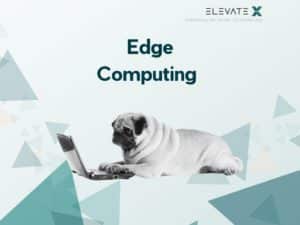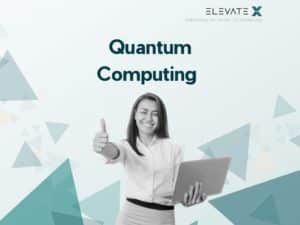“We will see more technological progress in the next decade than in the previous 100 years combined,” says Peter Diamandis from McKinsey, a management and strategy consulting firm. Understanding the impact of these tech trends can help avoid unpleasant shocks to the system, both for individuals and companies. Companies that make the most of technological progress are also in a good position to get the most out of their investments.
Trend 1: Artificial Intelligence
Artificial Intelligence, or AI, is an immensely broad topic, for which we’re just beginning to see the impact it will have on our daily lives and the way we interact with technology. Bernard Marr, the internationally bestselling author, and popular keynote speaker calls it “the most transformative technology humanity has ever developed”. Many of the other topics we will present here are or will be directly fueled by AI.
Before starting to imagine, that we are going to lose everything to machines, it is important to acknowledge that AI actually promises to improve various industries and create thousands of new jobs and professions. Some of them can already be identified today, like Data Scientists, Data Engineers, Machine Learning Engineers, and Software Engineers. There is, in fact, even a shortage of skilled labor force for this field – especially in Germany.
Rather than thinking of AI as a technology that will replace everything humans have been doing, Microsoft’s CEO, Satya Nadella, likes to think of AI more positively. He states that computing and AI are likely to get embedded in other technologies and enhance our capabilities as human beings.
Applications of AI
As mentioned previously, AI promises to change various sectors at once and will have a fundamental impact on our daily lives, as well as how we do business, and how we work.
In a recent McKinsey study, 50% of the respondents have stated that they have adopted AI for at least one business function.
Applications of AI are, therefore, not only limited to simple, repetitive tasks, as has previously been the case. With the increasing complexity of AI algorithms, the availability of data, and the emergence of Deep Learning, machines can learn increasingly complex tasks and perform well at them.
The following provides a non-exhaustive list of tasks that can be accomplished or at least assisted by AI:
- Autonomous vehicles
- Manufacturing robots and process optimization
- Natural Language Processing (NLP)
- Text generation
- Computer vision and image detection
- Disease detection
- Customer analytics
- Cybersecurity
Trend 2: Cybersecurity
In recent years, cyberattacks on companies and governments have increased sharply globally. Organizations are increasingly investing in a digital infrastructure to avert damage worth millions. The first step is to build up a good basis for protection, and then to check these systems for vulnerabilities.
Already in the course of 2021, we have dealt with the topic of cybersecurity much more intensively in our research and have written a number of blog articles on the subject. These included topics such as web and app security for FinTechs, as well as general topics on cybersecurity in the financial sector. Most recently, we have also included the verification of system security via penetration testing in our blog. (You can access the respective blog articles by clicking on the link).
Why Have We Taken Up These Topics? One Answer: Demand!
That’s right, the demand for freelance support in the area of cybersecurity has not left us unscathed. Especially when talking to customers and freelancers, we see that the market for this topic is growing very strongly. It is also apparent to everyone in the media that services in this area are urgently needed, since it is no longer just companies that have been feeling the effects of cyberattacks for a long time, but recently also consumers. In several articles, we also informed about the possibilities of criminals to carry out cyberattacks. Nowadays, it is not uncommon for targeted services and ready-made programs to be sold, with which massive damage can be caused.
As recently as November 2021, a digital attack took place on the largest chain of electronics stores, Media Markt and Saturn. In the stationary trade, there was a limited range of services – the Handelsblatt reported. One of the world’s largest service providers in the field of IT business and strategy consulting, Accenture, was also the target of a cyberattack in 2021. Such attacks show that no company is safe from cybercriminals – which is why a high level of protection and also innovations in this area are essential.
Cybersecurity in Companies
A fundamental component of cybersecurity is the Chief Information Security Officer (CISO). He is the person responsible for information security in a company. Interesting questions here are how a CISO works successfully and how companies can protect themselves against cyber risks and at the same time increase their competitiveness. KPMG addressed these two questions in an interesting article, listing seven steps to success. We consider three questions, in particular, to be especially important:
- How do I work together with the board?
As CISO, you form a crucial part of the Executive Board. As such, you must act accordingly. When it comes to important strategic decisions, a review of the CISO is indispensable. The goal must be to balance economic goals as well as security, according to KPMG. - How do I take advantage of automation?
Fundamentally, automation has many benefits. It helps reduce human labor and errors in repetitive work. It also increases efficiency and can mitigate the already serious staff shortages. Another major benefit in KPMG’s eyes is that automation can standardize the fulfillment of compliance requirements and security measures. This makes it possible to respond faster and better to cyberattacks. - How do I prepare for the future?
In particular, the topics of the Internet of Things (IoT) as well as 5G will increase the efficiency of companies in the coming years. New business models and systems are emerging. At first glance, companies will benefit from this, but if we take a closer look at the new data sources, it becomes clear that, in addition to the advantages, there are also enormous (data) risks. One of KPMG’s suggestions for solving these data risks is a data-centric security model, for example, based on the zero-trust principle.
Trend 3: Automatic Systems
Business and strategy consulting sees automation as a top trend, and so do we. We already talked about automation in the first trend, cybersecurity. Towards the end of 2017, BCG experts predicted in a press report “the automation” of almost eight million jobs in Germany alone. These employees were not just low-skilled workers: more than 60% of those affected were skilled workers, according to BCG.
How does this fit together? On the one hand, there is a shortage of skilled workers, on the other hand, there is a surplus? BCG partner Heinrich Rentmeister, quoted in the press report, sums up the situation and necessary development among German skilled workers and their employers well: “Digitalization and automation pose major challenges for the German labor market.” “The answer to these challenges lies in education and training. Qualifying the workforce for skills that will be in demand in the future is the bridge that brings together impending unemployment and rising demand for skilled workers.”
Concept-Based Continuing Education
BCG sees five fields of action for this “concept-based continuing education”:
- Formation of overarching competencies, which are already included in the dual vocational training system.
- Developing forecasts so that qualifications and skills that will be in demand in the future can already be integrated into vocational training and continuing education today. The keyword here is proactivity.
- Forming a wide-ranging and lifelong vocational guidance system. This should take into account the dynamic demands of the labor market.
- Better joint work and coordination between employers, authorities, and education providers.
- Development of an overall political strategy that integrates and coordinates the fields of action described above and creates an appropriate financing framework.
We at ElevateX had an example of what proactive automation must look like as recently as 2021 with our customer TENADO.
Automation at TENADO makes the daily routine of many employees considerably easier and creates scope for further creative development work. In this way, the company can create significant added value for itself – in cooperation between man and machine.
By the way:
You can find more success stories with our customers, among others in the financial sector, here.

Trend 4: Blockchain
Blockchain is a crucial component of automation that is already present, but above all of the future automation. In fact, blockchain can already be found in countless areas today: in data security, the IoT, AI, as well as in the financial sector – here for example in the form of smart contracts or tokens. Blockchain represents a form of distributed ledger technology (DLT). It is a shared domain formed by a consensus of synchronized and encrypted data. This has the advantage of eliminating or reducing the need for centralized intermediaries.
How does blockchain help in data security?
Tokenization helps companies create “digital identities” for parties and goods involved in distributed ledger transactions, allowing them to track goods along a supply chain, for example. The help provided by automated and standardized verification addressed in Cybersecurity is also of great benefit.
What are the benefits of blockchain in IoT?
DLT can eliminate the need for centralized control and reduce the risk of data tampering in IoT devices. Since IoT devices are mostly highly interconnected, high protection is of great importance here.
Where exactly does blockchain amplify artificial intelligence (AI)?
Blockchain’s ability to maintain privacy and data integrity, this promotes data sharing, which is essential for AI tools.
What's the deal with smart contracts?
Companies can use Blockchain technology to execute and verify “smart” contracts – so-called “smart contracts” to enable synchronization of delivery and payment. Blockchain addresses many shortcomings associated with each step of a transaction, including verification, matching and agreement, value and information transfer, and record-keeping.
In this article, you can read more about the different types and use cases of blockchains.
What are the benefits of tokens for the financial industry?
Blockchain makes it possible to digitize ownership, rights, assets, and tangibles of various kinds. If one follows the analyses and studies of the World Economic Forum (WEF), a value of circa 10 trillion US dollars could be tokenized with the help of the blockchain by 2029. In terms of financial instruments, tokenization is a digital securitization process. In this process, ownership of certain assets, rights and much more can be newly mapped via digital tokens.
Trend 5: Future of Connectivity
In the area of connectivity in particular, there are countless industries and applications that will be of great relevance in the coming years. In order to do justice to the most important trends in this area, we summarize here the top 3 trends of the future of connectivity.
Networks will become the key value driver
In recent years, cloud-network synergies have been achieved between the cloud and devices. The connection enabled content in the cloud to be displayed smoothly on different devices. Here, cloud-network synergy meant that networks could deliver their content services to devices over a cloud-device connection with a focus on downlink traffic.
With the strong growth of various real-time services, such as cloud VR, machine learning, and autonomous driving, the devices of the future will generate a huge amount of data that needs to be uploaded to the edge and cloud computing nodes for processing. Through this, we have the need to put a much stronger focus on uplink traffic in order to provide services smoothly.
In the era of cloud-network synergy, networks are cloud-centric. The high quality of service for requirements such as network connectivity and openness is guaranteed in the cloud. In the era of computing and network integration, networks are transforming to become more user-centric. This reorientation is reflected in higher security and reliability, as well as lower latency. All factors are the be-all and end-all of connectivity.
By the way, we have more on cloud computing and how exactly companies benefit from it in our blog article here.
Integration of cloud, networks and chips through new security architecture
The issue of cybersecurity is of great importance and is also reflected in the area of connectivity. The trends of increasing use of the cloud, mobility, and new technological innovations are blurring the traditional boundaries of security. Numerous experts and companies in the field of cybersecurity already agree that in the future, companies will no longer be able to guarantee security by defensively denying unwanted access. Cybersecurity should therefore extend to the devices themselves and chips.
Another issue related to cybersecurity is the use of artificial intelligence to defend against attacks. Attackers themselves are harnessing AI to amplify their attacks. Defense systems need to be smarter and able to predict dynamic developments in order to implement appropriate countermeasures.
With attacks already causing billions in damage annually and criminals not sleeping, we need to improve and combine the computing power and flexibility of the cloud, the physical security of chips, and the isolation and real-time collaboration of networks.
Network management shifts from software-defined to digital twins
A major technological advance has been seen in software-defined networking (SDN) and telemetry technologies in recent years. Here, the ability of software to abstract physical devices has improved.
In the coming years, AI will be further introduced into existing cloud-based network management platforms. Through this, it can learn from training data and learn closed-loop simulations of specific actions. This allows the AI to be trained and improved very well. These simulation cycles improve the robustness and predictability of the system. There are countless applications for this, including cybersecurity.
By the way:
We have summarized more about AI for you in a glossary. You can find this here in our blog article.
In the coming years, the ability to capture, model, simulate, predict, and control network data in milliseconds will be mature. New (integrated) computer architectures will be introduced and a digital twin network system for physical networks will emerge that is always available. This will further accelerate innovations. A decisive role in companies will be played by various people, including data scientists. For Data Scientists, this is part of everyday life: Finding suitable solutions to make events and facts measurable that cannot be measured directly. Read more about data scientists and how they help companies turn big data into smart data in our blog article.
Trend 6: Metaverse
The metaverse is one of the most controversial topics currently being discussed in the tech world. The metaverse gained attention first and foremost through Facebook’s name change to “Meta” as well as a video in which Mark Zuckerberg presents Meta’s plans.
“We firmly believe that we are on the threshold of a new era of the Internet,” says Tino Krause, Country Manager DACH at Meta, in an interview with DUP UNTERNEHMER. Mark Zuckerberg impressively shows what this metaverse is supposed to look like in an almost 80-minute video on YouTube.

By loading the video, you agree to YouTube's privacy policy.
Learn more
The technologies augmented reality (AR) and virtual reality (VR) are to be used significantly in the Metaversum. In the presentation, it becomes clear that the company wants to create a virtual world in which people can move freely. Whether visiting friends, experiencing concerts or playing sports, almost anything could be possible in the virtual world, in which users would be able to move physically. Zuckerberg himself proclaims the new revolution after the mobile Internet, and also sees his company in a process of realignment.
“We will transform from a social media company to a metaverse company.” Mark Zuckerberg, CEO, Meta
When the metaverse will be ready is not clear. In Facebook’s (now Meta’s) annual reports, one can see that there are big jumps in investments in research and development. Tino Krause, Country Manager DACH at Meta, considers a period of ten years to be realistic. Nevertheless, innovation should not be left to Meta alone, because numerous other companies will not leave this market to Meta without a fight. We will hear exciting things about this in the coming years.
By the way:
Mark Zuckerberg recommended some articles written by the ex-Amazon-Manager to his employees recently. You can find these articles, which show interesting ideas related to the metaverse, here.
You are searching for qualified tech-experts? We’d be happy to help you.
You are a freelancer and want to work on exciting projects? Then you can register for the ElevateX-Community here.








